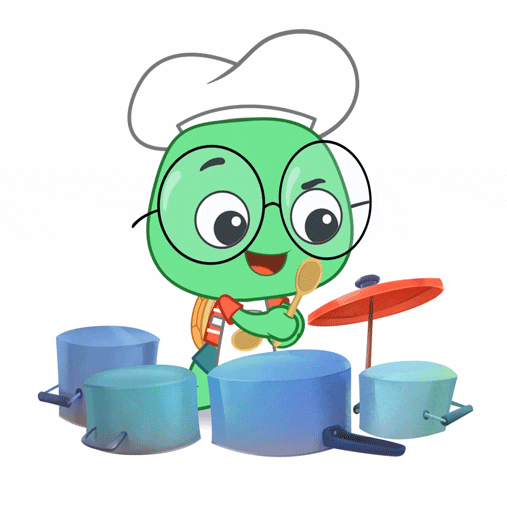Dazzling Danna Plays the Drums
Rational: This lesson will help children identify /d/, the phoneme represented by D. Students will learn to recognize /d/ in spoken words by learning a sound analogy of playing the drums and the letter symbol D, practice finding /d/ in words, and apply phoneme awareness with /d/ in phonetic cue reading by distinguishing rhyming words from beginning letters.
Materials:
-
Primary paper
-
Pencil
-
Chart with “Dazzling Danna played the drums all day”
-
Drawing paper and crayons
-
“Detective Dog and the Disappearing Doughnuts” by Valerie Garfield (https://www.youtube.com/watch?v=yvAGOa8f7G0 Amazon link: https://www.amazon.com/AlphaTales-Detective-Disappearing-Doughnuts-Alpha-ebook/dp/B00H9GUNBY)
-
Word cards with DOG, LOG, DIG, PIG, DARK, FORK, DROP, FOLD
-
Assessment worksheet identifying pictures with /d/ (https://easypeasylearners.com/wp-content/uploads/2017/02/Letter-D-Worksheet-Set.pdf)
Procedures:
-
Say: Our written language is like a secret code. It can be a little tricky to learn what the letters for – the mouth moves we make as we say the words. Today we are going to work on spotting the mouth move /d/. We spell /d/ with the letter D. D looks like a dime rolling up to a domino, and /d/ sounds like a drumbeat.
-
Let’s pretend to play the drums! Let’s all grab our sticks and play /d/, /d/, /d/! Do you notice how your mouth is shaped? (Touch mouth focusing on the bottom lip). When we say Danna played the drums, we touch the roof of our mouth with our tongue and almost touch our teeth together.
-
Let me show you how to find /d/ in the word dog. I am going to stretch dog out in super slow motion and listen for my drum beat. Ddd-ooo-ggg. Lets try one more time slower, D-d-d-ooo-ggg. I felt my tongue touch the roof of my mouth and my lips almost touched! So drumming /d/ is in dog!
-
Let’s take a look at our chart and try out our tongue tickler! Danna loves to play the drums! She has a talent show coming up that she’s really excited about. So, here’s our tongue tickler: “Dazzling Danna played the drums all day.” Now everybody say it three times together. Now say it again, and this time, stretch the /d/ at the beginning of the words. “DDDazzling DDDanna playeddd the dddrums all ddday.” Try it one more time, and this time break it off in the word: /d/azzling /d/anna playe/d/ the /d/rums all /d/ay.
-
[Have students take out primary paper and pencil]. We use the letter D to spell /d/. Say: Capital D looks like a dime rolling up to a domino. To write capital D, we start by drawing a straight line on our primary paper starting from the roof and ending at the sidewalk. Then we make a curved line, similar to a backwards C to connect the top and bottom of the line. If we want to write a lowercase D, we start at the top of the fence and make a small c between the fence and the sidewalk. Next, we need to draw a line from the roof to the sidewalk that connects it to the small c. After I check everyone’s Ds and put a check mark on your paper, I want you to practice each five more times.
-
Call on students to answer and tell how they knew: Do you hear /d/ in light or dark? Stand or walk? Dry or wet? Lunch or dinner? Say: let’s see if you can spot the mouth move /d/ in some words. Play the drums if you hear /d/: Dylan, brought, his, dinosaur, to, dinner, yesterday.
-
Say: Now that we know what sound the letter D makes and how to write it, lets take a look at this book so we can practice finding the letter. This is “Detective Dog and the Disappearing Doughnuts” by Valerie Garfield. Detective Dog loves to go to Dave’s Diner and his favorite desert to order is a doughnut. One day the doughnuts went missing so Detective Dog went on the hunt to find them. Let’s read to find out if he can find the doughnuts. While we read, we’re going to play our air drums when we hear the /d/ sound. Ask students to create their own dogs with silly names that start with D. Work will be displayed at the end of the lesson.
-
Show DIG and model how to decide if it is dig or pig: The D shows our drumming /d/, so this word is ddd-ig, dig. Now you try some! DOG: dog or log? DARK: dark or park? FOLD: four or fold? DROP: drop or crop?
-
For assessment, hand out the worksheet. Students will color pictures that start with the letter D. Then students will be called individually to read phonetic cue words from step number 8.
References:
-
Ivy Hughes, Derek D. Digs in the Dirt https://ivyhughes0004.wixsite.com/iah0004/emergent-literacy-design
-
Ashley Rella, Dana the Dizzy Dinosaur Stomps and Falls https://rellaashley186.wixsite.com/website/emergent-literacy-el-1
-
A Dime Rolls Up to a Domino https://sites.google.com/view/confusableletters/feature-sequence-stories
Dr. Bruce Murray (2012), Making Sight Words. Ronkonkoma, NY 11779.
-
“Detective Dog and the Disappearing Doughnuts” by Valerie Garfield (https://www.youtube.com/watch?v=yvAGOa8f7G0)
-
Assessment worksheet: https://easypeasylearners.com/wp-content/uploads/2017/02/Letter-D-Worksheet-Set.pdf
